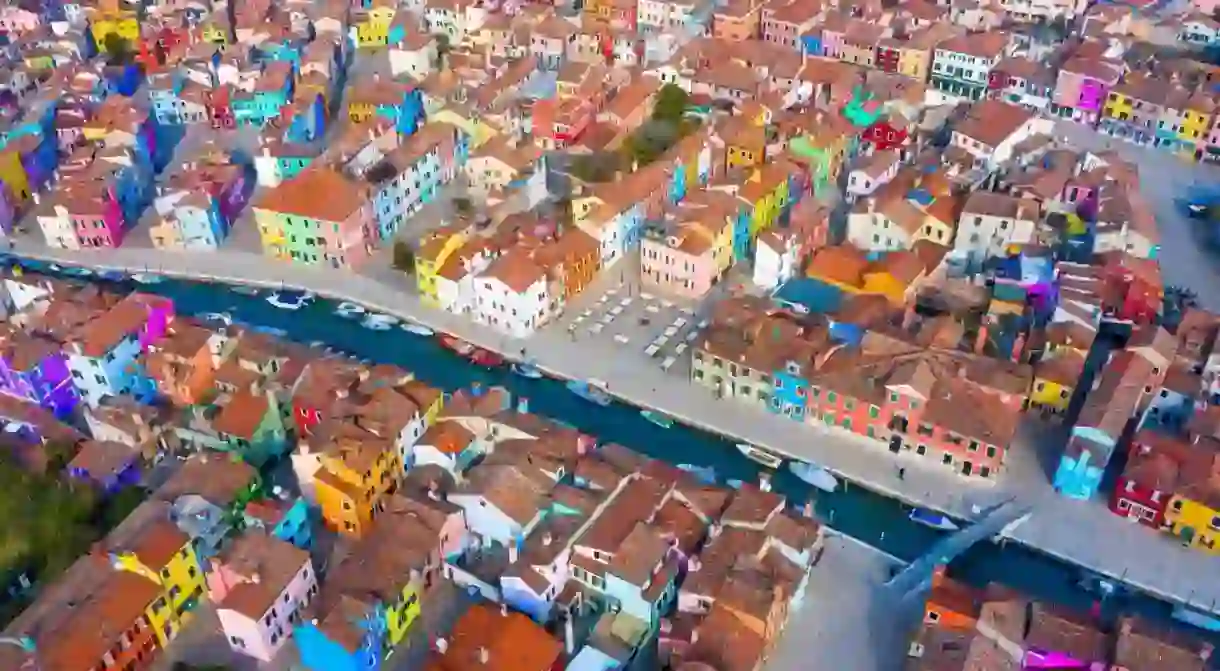8 Picturesque Day Trips from Venice by Boat

The floating city of Venice makes for a sublime spot to explore on foot, but it’s even better by boat. Wind your way along narrow canals, under yawning bridges, and through to the sweeping lagoon where you’ll find a peppering of other magical islands to moor up at. Highlights include characterful villages, historic churches, waterfront eateries, unspoiled nature reserves, and some splendid beaches. Here we reveal some of the best destinations in the Venetian lagoon to point your compass to.
Burano
Historical Landmark

Tourists flock to this picture-perfect island for its lace-making traditions and its brightly painted houses, which locals say were colored so fishermen could find their way home when fog blanketed the lagoon. The most colourful is Bepi’s House. A labour of love for the late Giuseppe Toselli, a local cinema operator, its exterior features a geometric pattern in bold shades of yellow, orange, red, green and blue. Linger for a while, making time to explore Burano’s three canals connected via a wooden bridge and Piazza Galuppi where you’ll see the leaning tower of San Martino church.
Sant'Erasmo Island
Historical Landmark, Architectural Landmark
Sant’Erasmo is Venice’s market garden, best known for its unique violet artichokes. The island – the largest in the lagoon – sits between Murano and Burano but is overlooked in comparison. In medieval times, it was a port, but by the 19th century, its population declined. It played more of a strategic role and today, it’s worth visiting the Massimiliana Tower, built in the 1840s during the Austrian occupation and the best preserved of the island’s military defences.
Torcello
Natural Feature

Torcello is busy with sightseers during the day, but in the evening and early morning, it’s an entirely different story. Moor up on Canale di Torcello and you’ll be right by the island’s centuries-old cathedral, Basilica di Santa Maria Assunta. Climb its bell tower for sweeping views across to neighbouring Burano. Another must-see is the Ponte del Diavolo, one of only two bridges in the Venice area with no parapets – the other is in Cannaregio – and according to legend, it was built in a single night.
Portosecco
Architectural Landmark
Midway along the strip of land that forms Pellestrina Island is the village of Portosecco. Like Burano, it has a long tradition of lace-making but unlike its crowded counterpart, its craftswomen and men are largely left undisturbed by tourists. Fascinating to watch, it’s a laborious process that involves crossing and pinning threads on wooden bobbins atop a padded cushion. It’s thought that the technique might have evolved from the skill of mending fishing nets, another tradition that you might see in action during your visit.
Ca’Roman nature oasis
Natural Feature
Birdwatchers will appreciate the importance of this nature reserve located on Pellestrina Island between the Venice Lagoon and the Adriatic. It is one of the most intact dune environments in the region. Sightings of more than 200 species have been recorded here. Kingfishers and Mediterranean gulls are permanent residents, while seasonal visitors include sparrowhawks, terns and plovers. Guided tours are sometimes offered, but this serene, calming space is a pleasure to visit on your own too.
Chioggia
Architectural Landmark

Chioggia is a sleepy fishing port that is often described as a “little Venice”. If you can, get there in time for the morning fish market; if not, settle in for lunch at one of its charming canalside seafood restaurants. Learn more about the local maritime environment at the fascinating Museum of Adriatic Zoology, housed inside the 300-year-old Palazzo Grassi. Devote the rest of your day to aimless wandering, but if you’re an art lover, you should make an effort to visit the Romanesque Chiesa di San Domenico for its decadent interiors.
Spiaggia di Punta Sabbioni
Natural Feature
Spiaggia di Punta Sabbioni is a beach that sits at the end of the narrow Cavallino-Treporti peninsula, close to Venice. Backed by grassy dunes and pine forest, it extends for over a mile. Wide and gently sloping, this unspoilt strip of sand is dog-friendly and popular with families. When the breeze picks up, the beach attracts kite-surfers. If you fancy something a little less active, take a peaceful stroll to the yellow lighthouse that stands guard on a breakwater at the end of the beach and from there you can watch thrillseekers in action.
Lido di Jesolo
Architectural Landmark
Lido di Jesolo is perhaps Veneto’s best-known beach resort. Purpose-built in the 1950s to capitalise on miles of yellow sand, today it’s a favourite among fly and flop package holidaymakers. There are plenty of facilities aimed at visitors: sunbeds and showers, ice cream parlours and beach-front snack bars, amusement arcades and bicycle hire. First aid points and lifeguards in peak season make this a safe place to enjoy a day at the seaside.













